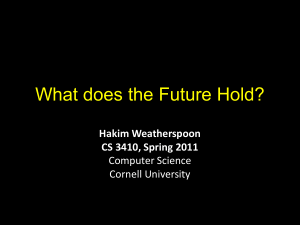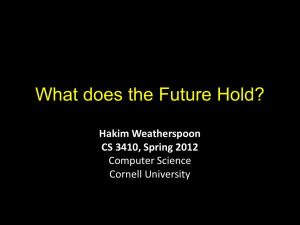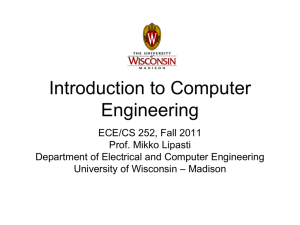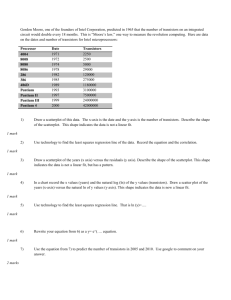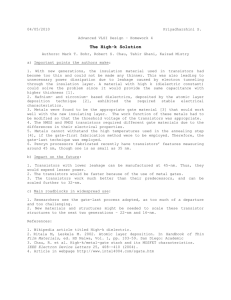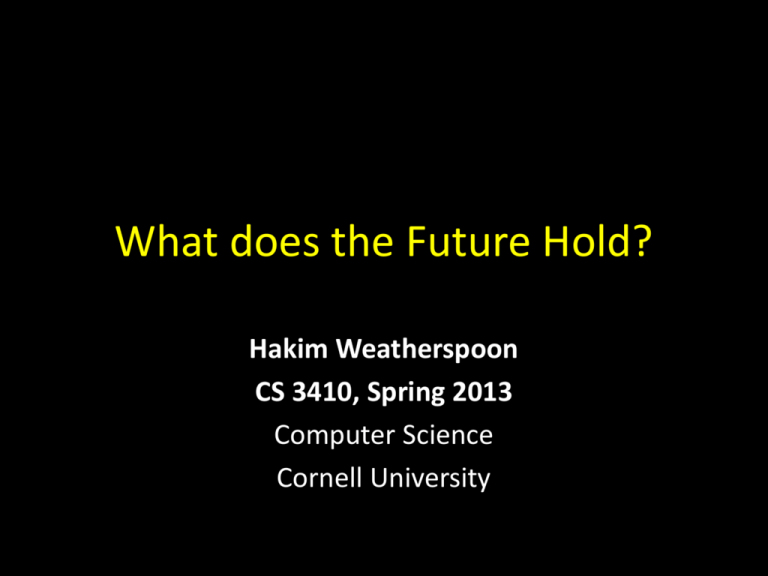
What does the Future Hold?
Hakim Weatherspoon
CS 3410, Spring 2013
Computer Science
Cornell University
Announcements
How to improve your grade?
Submit a course evaluation and drop lowest
homework score
• To receive credit, Submit before Tuesday, May 7th
Announcements
Final Project
Design Doc sign-up via CMS
sign up Sunday, Monday, or Tuesday
May 5th, 6th, or 7th
Demo Sign-Up via CMS.
sign up Tuesday, May 14th
or Wednesday, May 15th
CMS submission due:
• Due 6:30pm Wednesday, May 15th
Big Picture about the Future
Big Picture
How a processor works? How a computer is organized?
register
file
B
alu
D
memory
D
A
compute
jump/branch
targets
+4
Instruction
Decode
Instruction
Fetch
IF/ID
ctrl
detect
hazard
ID/EX
M
dout
forward
unit
Execute
EX/MEM
Memory
ctrl
new
pc
din
memory
ctrl
extend
B
control
imm
inst
PC
addr
WriteBack
MEM/WB
What’s next?
More of Moore
Moore’s Law
Moore’s Law introduced in 1965
• Number of transistors that can be integrated on a single
die would double every 18 to 24 months (i.e., grow
exponentially with time).
Amazingly visionary
•
•
•
•
2300 transistors, 1 MHz clock (Intel 4004) - 1971
16 Million transistors (Ultra Sparc III)
42 Million transistors, 2 GHz clock (Intel Xeon) – 2001
55 Million transistors, 3 GHz, 130nm technology,
250mm2 die (Intel Pentium 4) – 2004
• 290+ Million transistors, 3 GHz (Intel Core 2 Duo) – 2007
• 731 Million transistors, 2-3Ghz (Intel Nehalem) – 2009
• 1.4 Billion transistors, 2-3Ghz (Intel Ivy Bridge) – 2012
Moore’s
LawItanium 2
Dual-core
Ivy Bridge
K10
Itanium 2
K8
P4
Atom
486
386
286
8088
8080
4004 8008
Pentium
Why Multicore?
Moore’s law
• A law about transistors
• Smaller means more transistors per die
• And smaller means faster too
But: Power consumption growing too…
What to do with all these transistors?
Multi-core
Multi-core
http://www.theregister.co.uk/2010/02/03/intel_westmere_ep_preview/
The first transistor
• An Intel Westmere
• on a workbench at
AT&T Bell Labs in 1947
• Bardeen, Brattain, and Shockley
–
–
–
–
–
1.17 billion transistors
240 square millimeters
32 nanometer: transistor gate width
Six processing cores
Release date: January 2010
Multi-core
http://forwardthinking.pcmag.com/none/296972-intel-releases-ivy-bridge-first-processor-with-tri-gate-transistor
The first transistor
• An Intel Ivy Bridge
• on a workbench at
AT&T Bell Labs in 1947
• Bardeen, Brattain, and Shockley
–
–
–
–
–
1.4 billion transistors
160 square millimeters
22 nanometer: transistor gate width
Up to eight processing cores
Release date: April 2012
What to do with all these transistors?
Many-core
and Graphical Processing units
Faster than Moore’s Law
One-pixel polygons (~10M polygons @ 30Hz)
Peak Performance
('s/sec)
Slope ~2.4x/year
10
10
10
9
nVidia
G70
(Moore's Law ~ 1.7x/year)
8
UNC/HP PixelFlow
SGI
IR
7
Division
Pxpl6
UNC Pxpl5
10
10
SGI SkyWriter
6
SGI VGX
5
Flat
shading
UNC Pxpl4
HP VRX
4
86
HP TVRX
Stellar GS1000
SGI GT
HP CRX
10
SGI
R-Monster
ATI
Radeon 256
SGI Iris
88
Gouraud
shading
90
Nvidia TNT GeForce
E&S
3DLabs
SGI
Harmony
Cobalt
Glint
Accel/VSIS
Voodoo
Megatek
SGI
RE1
E&S
F300
E&S Freedom
SGI
RE2
Textures
PC Graphics
Division VPX
Antialiasing
92
Year
94
96
Graph courtesy of Professor John Poulton (from Eric Haines)
98
00
AMDs Hybrid CPU/GPU
AMD’s Answer: Hybrid CPU/GPU
Cell
IBM/Sony/Toshiba
Sony Playstation 3
PPE
SPEs (synergestic)
Parallelism
Must exploit parallelism for performance
• Lots of parallelism in graphics applications
• Lots of parallelism in scientific computing
SIMD: single instruction, multiple data
• Perform same operation in parallel on many data
items
• Data parallelism
MIMD: multiple instruction, multiple data
• Run separate programs in parallel (on different data)
• Task parallelism
NVidia Tesla Architecture
Why are GPUs so fast?
FIGURE A.3.1 Direct3D 10 graphics pipeline. Each logical pipeline stage maps to GPU hardware or to a GPU processor.
Programmable shader stages are blue, fixed-function blocks are white, and memory objects are grey. Each stage processes a vertex,
geometric primitive, or pixel in a streaming dataflow fashion. Copyright © 2009 Elsevier, Inc. All rights reserved.
Pipelined and parallel
Very, very parallel: 128 to 1000 cores
FIGURE A.2.5 Basic unified GPU architecture. Example GPU with 112 streaming processor (SP) cores organized in 14 streaming
multiprocessors (SMs); the cores are highly multithreaded. It has the basic Tesla architecture of an NVIDIA GeForce 8800. The
processors connect with four 64-bit-wide DRAM partitions via an interconnection network. Each SM has eight SP cores, two special
function units (SFUs), instruction and constant caches, a multithreaded instruction unit, and a shared memory. Copyright © 2009
Elsevier, Inc. All rights reserved.
General computing with GPUs
Can we use these for general computation?
Scientific Computing
• MATLAB codes
Convex hulls
Molecular Dynamics
Etc.
NVIDIA’s answer:
Compute Unified Device Architecture (CUDA)
• MATLAB/Fortran/etc. “C for CUDA” GPU Codes
What to do with all these transistors?
Cloud Computing
Cloud Computing
Datacenters are becoming a commodity
Order online and have it delivered
• Datacenter in a box: already set up with
commodity hardware & software (Intel, Linux,
petabyte of storage)
• Plug data, power & cooling and turn on
– typically connected via optical fiber
– may have network of such datacenters
Cloud Computing = Network of Datacenters
Cloud Computing
Enable datacenters to coordinate over vast
distances
• Optimize availability, disaster tolerance, energy
• Without sacrificing performance
• “cloud computing”
Drive underlying technological innovations.
Cloud Computing
Vision
The promise of the Cloud
• A computer utility; a commodity
• Catalyst for technology economy
• Revolutionizing for health care, financial systems,
scientific research, and society
However, cloud platforms today
• Entail significant risk: vendor lock-in vs control
• Entail inefficient processes: energy vs performance
• Entail poor communication: fiber optics vs COTS endpoint
Example: Energy and Performance
Why don’t we save more energy in the cloud?
No one deletes data anymore!
• Huge amounts of seldom-accessed data
Data deluge
• Google (YouTube, Picasa, Gmail, Docs), Facebook, Flickr
• 100 GB per second is faster than hard disk capacity growth!
• Max amount of data accessible at one time << Total data
New scalable approach needed to store this data
• Energy footprint proportional to number of HDDs is
not sustainable
What to do with all these transistors?
Embedded Processors
Where is the Market?
Millions of Computers
1200
Embedded
Desktop
Servers
1000
1122
892
862
800
600
400
488
290
200
0
1998
1999
2000
2001
2002
Where is the Market?
Millions of Computers
1200
Embedded
Desktop
Servers
1000
1122
892
862
800
600
400
200
488
290
93
114
135
129
131
0
1998
1999
2000
2001
2002
Where is the Market?
Millions of Computers
1200
Embedded
Desktop
Servers
1000
1122
892
862
800
600
400
200
488
290
93
3
0
1998
114
3
1999
135
129
131
4
4
5
2000
2001
2002
Where is the Market?
Millions of Computers
1200
1000
Cell Phones
PCs
TVs
785
800
600
502
405
400
200
295
11093
114
135
136
202
189
265
200
0
1997
1999
2001
2003
2005
2007
Where to?
Smart Dust….
Security?
Cryptography and security…
TPM 1.2
IBM 4758
Secure Cryptoprocessor
Security?
Stack Smashing…
What to do with all these transistors?
You could save the world one day?
ENIAC - 1946
First general purpose
electronic computer. Designed
to calculate ballistic trajectories
Alan Turing’s Bombe
Used to crack Germany’s
enigma machine
Smart Dust
& Sensor Networks
Games
Save the
world?
Embedded
Computing
Graphics
Security
Scientific
Computing
Cloud
Computing Quantum
Cryptography
Computing?
Survey Questions
Are you a better computer scientist and software
engineering knowing “the low-level stuff”?
How much of computer architecture do software
engineers actually have to deal with?
What are the most important aspects of computer
architecture that a software engineer should keep
in mind while programming?
Why?
These days, programs run on hardware...
… more than ever before
Google Chrome
Operating Systems
Multi-Core & Hyper-Threading
Datapath Pipelines, Caches, MMUs, I/O & DMA
Busses, Logic, & State machines
Gates
Transistors
Silicon
Electrons
Why?
Your job as a computer scientist will require
knowledge the computer
Research/University
Industry
Government
Where to?
CS 3110: Better concurrent programming
CS 4410/4411: The Operating System!
CS 4420/ECE 4750: Computer Architecture
CS 4450: Networking
CS 4620: Graphics
CS 4821: Quantum Computing
MEng
5412—Cloud Computing, 5414—Distr Computing,
5430—Systems Secuirty,
5300—Arch of Larg scale Info Systems
And many more…
Thank you!
If you want to make an apple pie from scratch, you must first
create the universe.
– Carl Sagan


